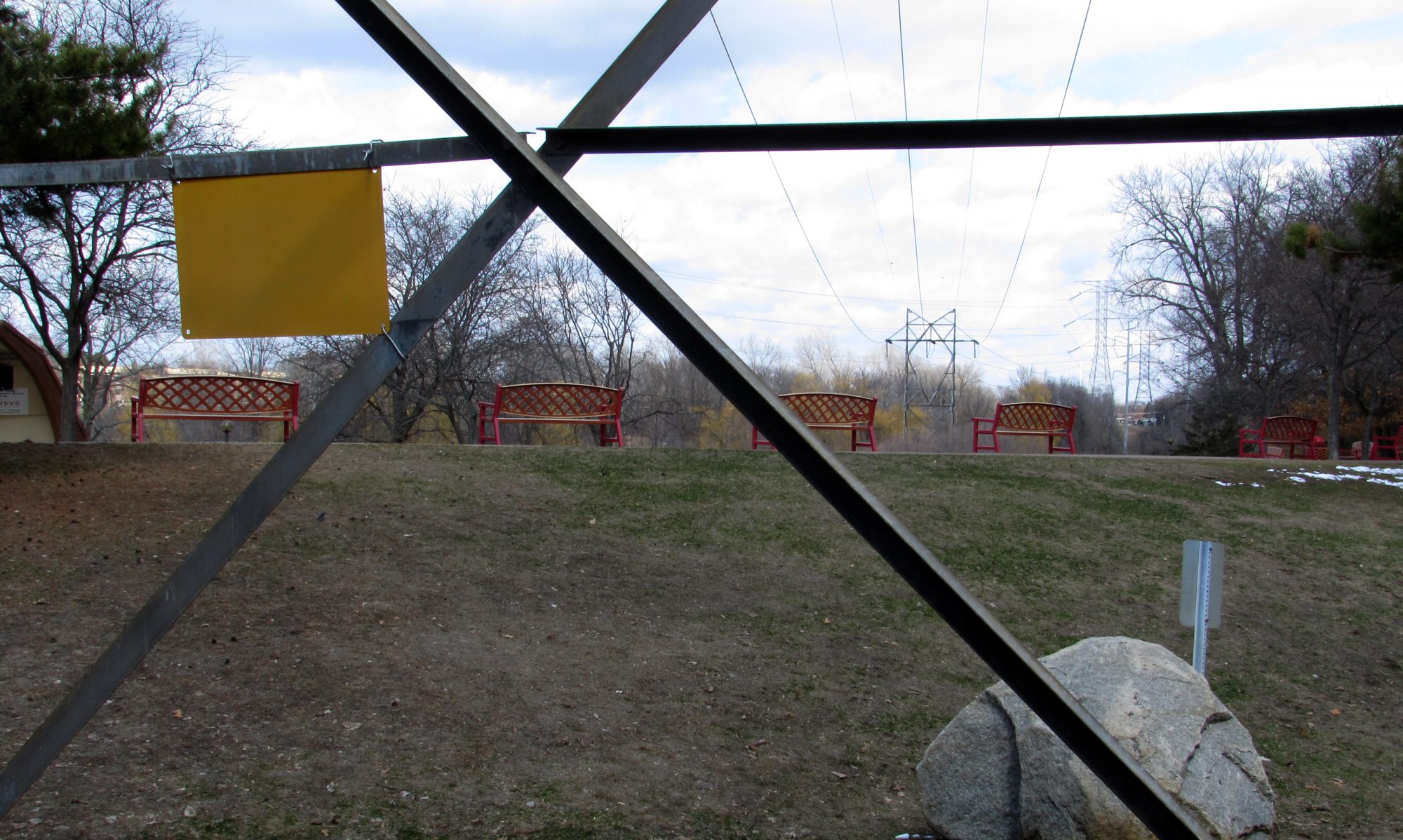This post is third in a series of reflections on the tenth year of Full Spring Studio. See the index of Tenth Year Reflections for a chronological list and more about the series.
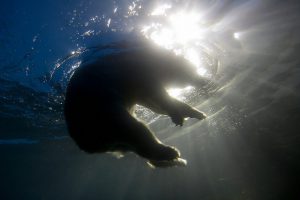
From the post of April 4th, 2017: “As I grew and tried to find my place, art and mud (well, clay) would reappear, but I was on a different mission meant for more important things, I thought. In the next posts, the protagonist tries to grow up, and leaves home in search of her proper place in the world.”
I think of life after about second grade to sometime in college – the early growing up years, in a couple of ways. Reading about archetypes lately, makes me realize in some ways it was a time to be the “martyr.” Not in any grand gesture of sacrifice, though. Just everyday sacrifice of identity and voice that children experience as they try to make sense of how to be members in the world around them, surrendering themselves to an external identity. But I also think of it as a time of being a “wanderer,” the archetype that leaves home in search of identity or meaning. But I was a secret wanderer. And I didn’t leave home at first. I traveled below the surface, perhaps even traveling below my own awareness, exploring an inner life and negotiating my relationship with Nature.
Jung says If you ignore parts of the wholeness of life, leaving things unspoken and unrecognized, that they keep showing up until you recognize them. I wonder, were my recurring themes that kept calling always present, pre-emergent below consciousness? Were they pressed down? And how can they breathe and maintain their power when suppressed for years or decades on end? Even if trying to conform externally, does the inner, subconscious life progress?
Reader, Do you remember a time of life when you were focused on fitting in or staying small versus self-discovery and self-expression? What clues about your life then might reveal values, desires, and themes growing below the surface and developing the roots of your identity? The roots of your creative resources? The roots of your connection to the Earth?
At first, school was an extension of the human inside world of walls and windows and words. A comfortable place like home, but with new people. But by second grade, just as my view of the earth changed—had fallen— my view of the inside world of school also fell from innocence. I was surrounded by wolves and I learned to behave like a rabbit: staying still and quiet, hoping to be invisible to escape the predators (class mates) that hunted the meek and sensitive, as they vied for alpha-child, or at least part of the lead-pack. It was not safe to grow externally, so I burrowed underground, and swam underwater.
Now as I said before, this is not a life story per se, but a search for clues about the roots of connection and flow in the journey of creative growth and earth relationships that shape later artwork. So I will continue to collect artifacts. I think perhaps a listing of memories makes sense. More sense than a cohesive narrative arc of my childhood here, since the things that are most important were concealed, held safe or secret or secondary. So, here are scraps of evidence of my life below the surface, that when put together may later explain how my land-mammal self could continue living underwater.
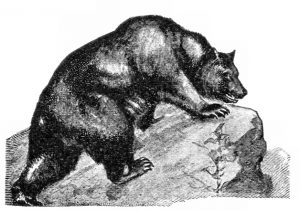
- In addition to the social predators by school-day, I was hunted at night by a giant black bear. The same one whose hide I’d played on as a baby. A desperate (or careless) babysitter had used it as a threat. “Behave or I’ll tell the bear to get you!” For years afterward I had recurring dreams of the black bear approaching me from behind, reaching for my shoulder. I tried to scream, but I had no voice. Then I’d wake up. It was after me often enough and long enough to be a significant image of my childhood.
- I watched Wild Kingdom, and, like what seems innate to so many children, I was sad for the Gazelle, although I knew the Lion had to eat. This was a moral dilemma. I remember coming to resolution through a relativism of morality. What is “good,” is what is good for the group you are part of. What is bad is what is bad for the group you are part of. The Gazelle is not part of the Lion’s group, so the Lion is not bad for killing it. (This later helped explain war: people are willing to kill those that are not in their group.) I didn’t like it, but it was how I made sense of the world around me.
- I described our living room full of taxidermy in the last post. I did not experience the heads and bodies as killed animals, but rather as stuffed sculptures. I knew they used to be alive, but did not think about their deaths. Just about their current forms.

- On the other hand, I personally participated in killing other animals. When I put a worm on a hook. When I caught a fish and cleaned it. When I slapped a mosquito. In younger years, I remember finding a dead bee, and weeping for it, then holding a burial ceremony. But now, on butterfly hunting trips with my dad, we’d carefully remove the Wood Nymph, or Red Admiral, or Monarch from the net, pinch its thorax, and place it in a jar of poison that would kill it and also keep it soft, so we could mount it in a cigar box, using the long thin black insect pin to pull its wings into position and set it in place just like the posed taxidermy in our living room. I didn’t like killing animals, but it was how things were done. We were Lions, and they were Gazelles. We didn’t mean them any harm, we just took their lives for our use.

- I was in the lake a lot. Most of the time, I was mostly under the surface. Being under the diving raft, kept me hidden from the sun, and made it easier to see below. One year, my neighbor and I discovered a Minnesota deep sea treasure: an underground patio of hexagon pavers each a foot and a half across, set on a wooden platform. Had someone made a concrete dock? Did the lake used to be lower? Did it slide down the lake bottom from shore? Like many explorers, we did not leave it alone, but commenced collecting it. Diving for the pavers, lifting them up so their tips emerged from below, handing it to the co-explorer in the row boat. We stacked the collection behind the boat house, where they may still stand today.
- I didn’t make mudpies anymore. But in 6th grade summer school I took a pottery class with my neighbor and was reunited with the soul of mud. From then on, I fell in love with pottery, which was the first art form to show me how my whole body was part of art making. I took pottery in summer school, and eventually my parents set me up with a wheel in the basement, though we didn’t have a kiln. The clay studio was the well room. It had cinder block walls, one uncovered incandescent bulb in the ceiling, a sink, and a glass block window that caught bits of light from under the porch. It was a very basement-y, underground-y, room. As I would work on the wheel, the well pump would come on and off. It was loud and startling. I vaguely sensed that it was connected to a pipe that went underground, down below some uncharted territory in my concept of space. I knew our basement was set into the earth, but what was further down was a vague blackness, that could be better described as “below” than an actual place in my perception. Only now do I see the connection that there was perhaps a relationship between the lake level and how far down to the water table our pump pipes would have gone.
- My bedroom was also in the basement. Its window sills were high on the inside, and just above ground level on the outside, and so I looked out on the stems of flowers, and at squirrels at my eye level. There was a heating vent on the other wall that connected to the furnace next to my room. I was particularly conscious of it being next to my room because it made noise I could hear through the vent. My consciousness of the furnace grew as I got older, because my family added a wood burning furnace, keeping the oil burning one for back up. Each winter weekend, my brother and I would haul a week’s worth of wood in our basement for my dad to load into the furnace, morning and night, throughout the week. I learned to saw and chop wood. When I was out with my dad in the car, if he saw a fallen tree or log along the road, we would stop and take the bow saws he kept in the trunk to harvest the wood. The world was full of fuel. And we fed it into the furnace box to be eaten by fire.
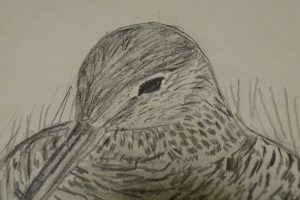
- Insect labels. My dad, a forest entomologist, got his teeny tiny insect labels in 2 point type mixed up and paid me a quarter to use my sharp-sighted child-eyes to sort them. They were the names of insects he studied. Yellow-headed spruce sawfly, Gypsy moth. I forget the rest now. I loved how tiny they were. Collecting and categorizing were part of his work, and it felt peaceful and orderly to help put the labels in their own envelopes.
- We had a vegetable garden, and my brother and I could each have a few rows when we were old enough to tend it. We put a wooden stake on both ends of a row, and stretched a white laundry rope across, so we could hoe a valley in a straight line. Then we placed the seeds evenly, cover, pat, and water. In spring it was an orderly process. Then as summer came on, and weeds grew faster, I would get behind, and it would start to get overgrown. My Dad would reinforce how important it was to keep the weeds down, but I couldn’t keep up. I was relieved and reassured when I realized that some things still grew- like carrots, and radishes, even without my maintenance. The plants had a life of their own, and could take care of themselves without me, even if the yield was smaller.
- Butterfly cages: In another area near the garden, my dad had built butterfly cages—covered cubes formed out of old window screens. He was a forest entomologist with a side hobby of studying butterflies, and these cages were placed over different host plants to compare how well the butterflies did on each one.
- In junior high, the art class had a stack of Audubon magazines that we could use for art exercises. The beautiful, telephoto photography allowed me to feel close to the birds I painted and drew. I could study the curve of their eye, or the changing shape of their feathers on their wing. It created a view I couldn’t experience in real life. An unnatural intimacy with a creature (or its image) that would otherwise flee if I were really that close. The views were iconic. A bird standing on a snowy plain, with its shadow in blue. A duck and her ducklings in a nest, arranged for my view like a family portrait. The birds didn’t make any sounds, and they didn’t move. They were forms. But even in their static presentation, I loved them. I related to their faces as much or more than those of humans.

- In winter, my dad would take us hiking. Often we went along the Mississippi River by steep inclines, and explored the ice caves that formed from frozen drainage near the top of the cliffs. I remember the hikes as extremely bright, with the sun reflecting off of the snow. We’d often build a small fire, and cook a hot dog, which enhanced the appeal of the Winter chill in contrast to the warm food.
- At the end of elementary school, we moved to Florida for a new job my Dad got there. I was horrified to leave my friends. And depressed about the high heat and humidity – even in comparison to Minnesota summers. We had a house near water, but weeds covered the shore, and we were told there could be crocodiles. I retreated indoors to the air conditioning, and my deepest retreat was a closet in my bedroom that was connected to the air ducts in such a way that it was nearly a wind tunnel, and cooled me off quickly. Florida had new creatures, like the invincible cockroach. I tried to kill it with my pre-teen cowboy boots with the chunky heels and it would not die. I felt defeated. Two months into school, with my dad’s job not as advertised, and the family miserable in the new location, we moved back to Minnesota to our house that hadn’t sold, and my Dad returned to his position, which hadn’t been filled yet. It was as if it hadn’t happened at all – a bad dream, and I awoke back in my own land.
- The lake was my point of reference year round. In winter I skated and cross country skied on it, in spring through fall, we canoed or went fishing in the row boat, and in summer, I was in the water as much as possible.
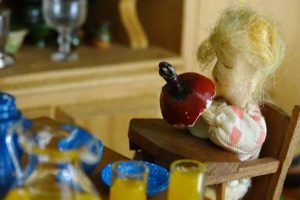
- I loved miniatures. I had a display case for my collection and it was understood that I wanted miniatures for birthdays, and Christmas, just like my other friends wanted anything dog related or horse related for their collections. I loved—craved—the smallness of the world I created. The more realistic and crafted, the better, but I also liked to convert a toothpaste cap and a bit of baby’s breath into a potted plant.
- In 6th grade, in an electricity unit, I wired a miniature room with switches and lights. I liked the miniature wires behind the cardboard walls, which faced the outside of the diorama box. I was captivated by the small brass candle sticks with little light bulbs on top. But I didn’t understand how electricity worked. I could memorize and complete the assignment, but became tormented by not “getting it.” Finally after multiple meetings with the teacher and coaching by my mom, I learned (at 6th grade level) about electrons and how electricity could “flow” even though nothing appeared to move.
- My mom reupholstered two sample chairs from a furniture store. Half-size wing back chairs, one for me and one for my brother. They sat closest to the fire place and were our perches after bath time.
- In addition to the taxidermy above the fireplace with its central moose head, were daintier creatures – or pictures of them. My dad had framed page spreads from a butterfly identification book and hung them on the face of the fireplace so one could see the detail up close – the spots, antennae, and tiny print with their Latin as well as common names.
- To either side of the fireplace were two tables – really two halves of one table. My dad had taken an antique library table and sawn it in half because he thought it looked good in those two corners. The left side facing the fireplace was my brother’s fort, and the right one was mine. We’d crawl under the tables and be half visible while adults talked in the big chairs. We installed toys out of view in the old drawer runners up inside the table. These were our own architecture, to furnish and inhabit.
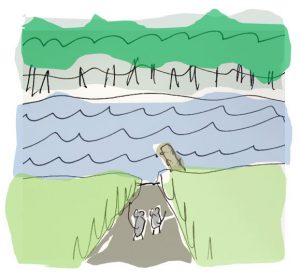
- My dad made up stories to tell us about Mooshy Mouse and Morris Mouse. They all started with: “Once upon a time there were two little mice named Mooshy Mouse and Morriss Mouse who lived in a meadow and ate seeds and berries. One day…” I think my favorite one was the time they went on an adventure down the Mississippi River in a sardine can. They were vulnerable due to their size, but they always got out of the messes they got into.
- Words were play things in my family. Instead of groans, the dinnertime puns which flowed freely were met with admiring “Aaaahs,” rather than “Ughs.” Words made us smile, and bonded us together.
- The most important words for my mother were written by Shakespeare. She identified with the English portion of her heritage from her dad, and at 12 or 13 her aunt had given her a green hardcover book of Shakespeare’s writings, that she kept by her side the rest of her life. It was her solace when she was bedridden for a year at age 13. She could recite famous lines, and had page marks for favorite sections. For my Halloween party, she dressed as a witch with a long gray wig, and used an antler to serve spaghetti to my girlfriends while reciting the witches scene from Macbeth. No one found an “eye of newt” nor “toe of frog” in their spaghetti, but everyone enjoyed her theatrical presentation.
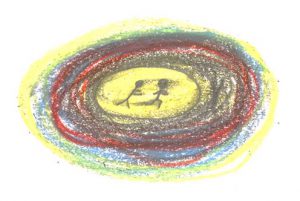
These selections are mostly nice memories, or ones that hold meaning for my creative life and relationship to the earth. They may be what kept my inner-self alive and growing despite memories, that that shaped my external self that had me struggling—and later, more dangerously, defeated and passive as if invisibility would save me. As if a rabbit could stay so quiet to be safe. Eventually the pressure of containing and concealing myself would be too great and I would break through the invisible shell – which had become more a trap than a protection.

